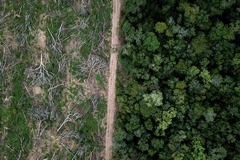Scientists leverage machine learning and data science to improve chickpea farming
Scientists in Israel have developed a machine learning (ML) tool that combines satellite imagery and weather data to monitor chickpea crop health. The system accurately estimates values such as the Leaf Area Index (LAI) and Leaf Water Potential (LWP) in commercial fields, to help farmers make smarter irrigation decisions and improve yields.
Machine learning is emerging as a key tool in the food industry, helping predict pre-harvest tomato quality and, when paired with methods like DNA barcoding, combat honey fraud.
The research, conducted by the Hebrew University of Jerusalem, integrated high-resolution Sentinel-2 satellite imagery with weather data to estimate key plant health indicators, such as LAI and LWP. These factors play a critical role in understanding canopy development and water stress in chickpea, a vital crop for semi-arid regions worldwide, note the researchers.
“The ML is used to estimate and validate chickpea traits, the estimated values with their spatial distribution support decision making that at this point in time are in the hands of the growers,” Omer Perach and Dr. Ittai Herrmann from the Faculty of Agriculture at Hebrew University, tell Food Ingredients First.

“Our goal was to create something that doesn’t just work in the lab but helps farmers in the field. With this system, we can offer growers spatial maps of plant development and water status across their entire field. This kind of information allows for more precise and timely irrigation,” adds Perach.
The study, published in the European Journal of Agronomy, combined data science with agronomy to test the machine learning models using a “leave-field-out” strategy. This strategy mimics real-world conditions where new fields have not previously been used to train the models, making the tool relevant and reliable for practical use.
Improving yields
The study states that the team’s machine learning models achieved high accuracy for estimating LAI and were able to distinguish between different levels of water stress, even under real-world variability across 17 commercial fields.
By combining plant growth maps with watering schedules, the researchers showed that farmers could anticipate what their crops need and boost their harvests.
“The response of chickpea plants to irrigation regimes can be observed from space,” says Herrmann. “What we’ve developed is a scalable way to detect within-field variability using free satellite data and standard weather station inputs. This helps transform intuition-based farming into data-driven management.”
The team faced various on field challenges during the study, Perach and Herrmann tells us. “ The data collection was a big challenge. In our models real field-measured values are used (hundreds of samples were acquired in commercial fields).”
The scientists expect the findings to lay the groundwork for integrating these models into platforms like Google Earth Engine, for global farmer access, including regions with limited technical infrastructure.
“Another paper is under review now for using more advanced tools in Google Earth Engine,” they tell us.
In the future, for the model to evolve for other crops, the scientists suggest that “data should be acquired, models should be developed.”
“The tool is freely available to use, it can help people make decisions based on more information than without using the tool. If there is a smartphone with reception the GEE tool can work,” Perach and Herrmann conclude.
The Hebrew University Intramural Research Fund, the Association of Field Crop Farmers in Israel, and the Chief Scientist of the Israeli Ministry of Agriculture and Food Security supported the research.











